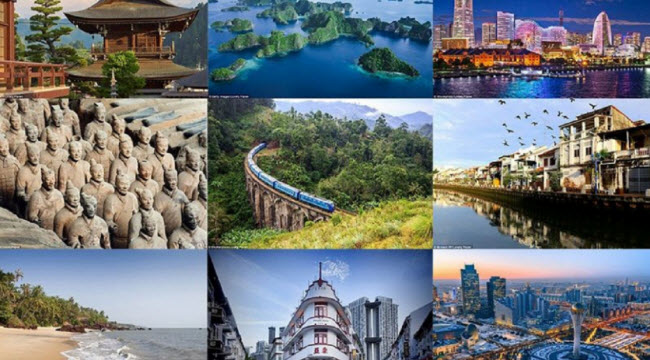Asia is the largest continent on Earth in terms of both area and population. It shares its borders with Europe and Africa to the west, Oceania to the south, and North America to the east. Additionally, its northern boundary extends into the Arctic region, alongside North America and Europe. Although most of Asia’s continental borders are well-defined, there are some ambiguities due to the technical fact that Europe and Asia are part of the same landmass, which is why the term “Eurasia” is sometimes used to describe both. The ease of movement across the land borders of these continents often leads to some countries located on Asia’s western edge being referred to as part of Eastern Europe, such as Armenia, Azerbaijan, and Georgia. These countries are sometimes seen as Asian and at other times as European. Russia and Turkey, for example, are often divided along geographical lines: Russia is generally split along the Ural Mountains, with its western part known as “European Russia” and its eastern part simply as “Russia.” Turkey is divided by the Bosporus Strait, with the land between Istanbul and its borders with Bulgaria and Greece considered part of Europe, while the rest of its territory, known as Anatolia, is part of Asia.
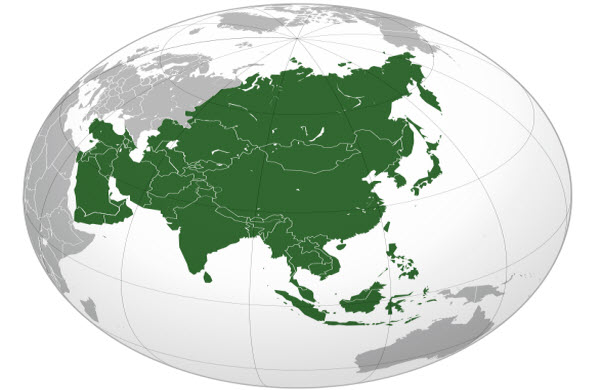
On the continent’s other side, the islands that separate Asia from Oceania can also be challenging to define. “Indonesia” and parts of “the Philippines” are sometimes classified as part of Oceania rather than Asia. However, it’s important to note that these divided regions do not constitute separate countries or autonomous regions claiming sovereignty, such as Hong Kong’s case. “European Russia” and “Russia” are, in reality, the same country, the Russian Federation, but maps sometimes shade these areas differently to help delineate the borders between Asia and Europe.
Asia covers an area of approximately 44.6 million square kilometers, making up about 30% of the total land area on Earth. “Russia” is the largest country on the continent, followed by “China,” “India,” and “Kazakhstan.” The smallest Asian countries include “the Maldives,” “Singapore,” “Bahrain,” and “Brunei.”
Asia is divided into several regions. “West Asia” includes countries such as Afghanistan, Bahrain, Iran, Iraq, Palestine, Jordan, Kuwait, Lebanon, Oman, Qatar, Saudi Arabia, Syria, Turkey, the United Arab Emirates, and Yemen. The “Caucasus” region, located northeast of Turkey, is a mountainous area between the Black Sea to the west and the Caspian Sea to the east, comprising Armenia, Azerbaijan, Georgia, and parts of Russia. “Central Asia,” located north of Iran and Afghanistan and south of Russia, consists of Kazakhstan, Kyrgyzstan, Tajikistan, Turkmenistan, and Uzbekistan. “East Asia” lies between Central Asia and Russia and the Pacific Ocean, extending nearly to the Tropic of Cancer, and includes China, Japan, North Korea, South Korea, Mongolia, and regions like Hong Kong, Macau, and Taiwan. The “South Asia” region, also referred to as the Indian subcontinent, is separated from East Asia by the Himalayas between China and India and is largely defined by the Indian tectonic plate on which its countries rest. This region includes Bangladesh, Bhutan, India, the Maldives, Nepal, Pakistan, and Sri Lanka. Finally, “Southeast Asia” lies between South and East Asia to the north and Oceania to the south and includes Brunei, Cambodia, Indonesia, Laos, Malaysia, Myanmar (or Burma), the Philippines, Singapore, Thailand, Timor-Leste, and Vietnam.
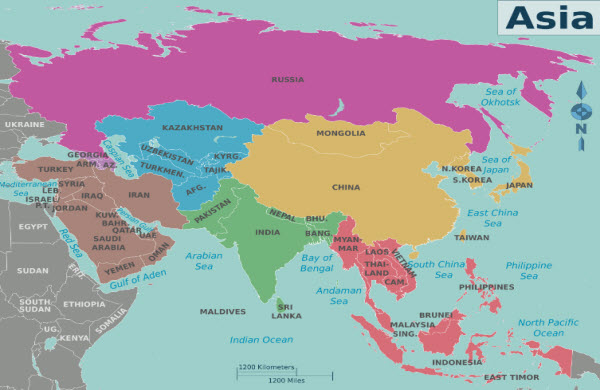
Asia also contains several unrecognized or partially recognized states, such as Abkhazia, Nagorno-Karabakh, and South Ossetia in the Caucasus, all of which declared independence in the 1990s with limited international recognition. In addition, Northern Cyprus declared its independence in 1983 but is only recognized as a sovereign state by Turkey within the United Nations. “China” considers cities like Hong Kong, Macau, and Taiwan part of its territory, even though each sees itself as either fully independent (in the case of Taiwan) or semi-autonomous (in the cases of Hong Kong and Macau), operating independently in currency and government and enjoying varying degrees of international recognition as separate states. Taiwan represents itself in international forums under various names, with its official name being the “Republic of China,” referring to the state that governed the mainland until the Chinese Civil War before the Communist Party took power. The “People’s Republic of China” refers to Taiwan as “Chinese Taipei,” while the rest of the world deals with it under the name “Taiwan.”
Geography of Asia
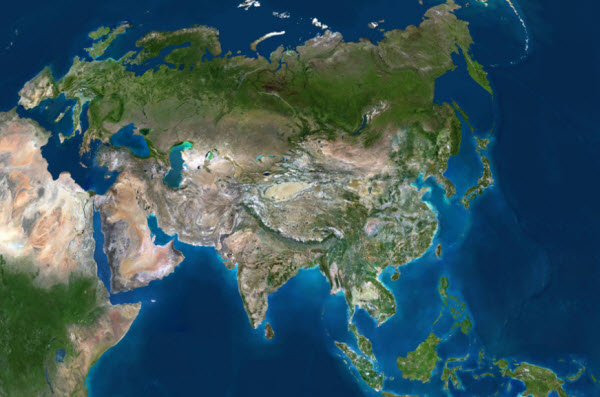
Asia’s vast size allows for a diverse range of natural and geographical phenomena, depending on its regions. West Asia experiences the highest temperatures on Earth due to its warm desert climate, with parts of Iraq and Iran recording temperatures exceeding 71°C (159.8°F). In contrast, Asia is also home to the coldest inhabited weather globally, with temperatures of -67.7°C (-89.9°F) recorded in two Russian cities, Verkhoyansk and Oymyakon. The northern half of “Russia” features a subarctic continental climate similar to that of “Alaska” in the “United States” and much of “Canada,” with its far north classified as polar tundra, comparable to the far northern Canadian territories or the coasts of “Greenland.”
Asia is also home to both extremes of rainfall. Some of the driest places on Earth can be found in the desert climates of West Asia, its central plains, and parts of “China” and “Mongolia.” Meanwhile, the village of “Mawsynram” in northeastern India is one of the wettest places on Earth, with an average annual rainfall of 11,872 mm. South Asia experiences a mix of monsoon weather, leading to heavy rains alongside tropical savannas with extreme heat. The climate patterns involving the Indian and Pacific Oceans cause most of East Asia to have a temperate climate with a heavy monsoon season, particularly in East “China,” “Hong Kong,” “Macau,” “Taiwan,” “South Korea,” and most of southern “Japan.” Most of continental Southeast Asia has a savanna climate similar to some of the driest parts of South Asia, while the island regions between Asia and Oceania are known for their tropical rainforests.
The Syrian and Arabian deserts in West Asia are among the world’s largest, as is the Gobi Desert between “China” and “Mongolia” in Central Asia. It’s also worth noting that many of the continent’s massive natural features are responsible for the different weather patterns in Asia. For example, the height of the “Himalayas” blocks rain clouds from the Indian Ocean, pushing them back to the Indian subcontinent while preventing cold northern air from traveling south, resulting in hot monsoon weather in South Asia and the cold deserts and steppes of Central Asia.
History of Asia
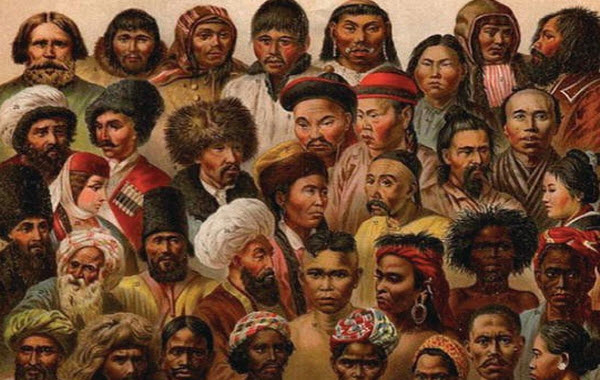
Given its immense size and diverse populations, it is nearly impossible to present a unified history of the continent, which is the birthplace of nearly all major religions and many technological and civilizational developments. West Asia is often called the “Cradle of Civilization,” where humans began transitioning from the Neolithic era to a nomadic lifestyle and then to a settled way of life, inventing the wheel and basic agricultural techniques. West Asia was also home to the earliest known human civilizations, such as ancient Sumer and the Assyrian, Babylonian, and Akkadian empires. The Indus Valley Civilization, the earliest known civilization in South Asia, also emerged here. In the east, the Xia Dynasty was the first recorded civilization of ancient China.
Demographics

Asia has a population of approximately 4.4 billion people, accounting for 62% of the world’s 7.1 billion population, making it by far the most populous continent on the planet. China ranks first (1.4 billion people), followed by India (1.3 billion), Indonesia (259 million), and Pakistan (193 million). The least densely populated countries are the Maldives (341,000 people), Brunei (412,000), Bhutan (771,000), and Timor-Leste (1.2 million).
Many different religions are widely practiced across Asia. Islam ranks first, with approximately 1.1 billion people, representing about 25% of the population, making it the most widespread religion, especially in the west, and the only official religion in many countries, practiced by nearly 100% of the population in countries like “Kuwait” and “Saudi Arabia.” However, most Muslims live in South and Southeast Asia, with countries like “Bangladesh,” “India,” and “Pakistan” each having over 100 million Muslims. “Indonesia,” in Southeast Asia, has more Muslim believers than any other country. Hinduism is the second-largest religion, closely following Islam, with nearly a billion adherents. It is most prevalent in “India” and “Nepal” (where over 80% of the population follows it) and has strong minorities in many Southeast and West Asian countries. Christianity is also widespread, with Orthodox Christianity prevalent in “Armenia,” “Georgia,” and “Russia,” Catholicism in “East Timor” and “the Philippines,” and Protestantism largely in “South Korea.” Other prominent religions in Asia include Sikhism and Jainism, primarily found in “India” and “Pakistan,” as well as Judaism and Zoroastrianism, the first Iranian religion still practiced in parts of modern “Iran” and other countries.
After Islam and Hinduism, irreligion is technically the third most widespread “religion” in Asia, with about 21% of the continent’s population having no particular religious affiliation, especially in “China,” “Hong Kong,” “Japan,” and “North Korea.” This can be partly explained by the communist state policies in “China” and “North Korea” that strongly discourage religious beliefs and practices. Many Asian countries, such as “Cambodia,” “Laos,” and “Vietnam,” have significant atheist populations.
Economy
Asia’s economy is incredibly diverse, reflecting its geographical and demographic diversity. The continent is home to some of the world’s fastest-growing economies, such as “China,” “India,” and “Vietnam.” “China” has emerged as the second-largest economy globally after the “United States,” measured by nominal GDP. Major industries across the continent include manufacturing, technology, agriculture, and services.
China’s rapid industrialization has transformed it into the world’s largest manufacturing hub, producing everything from electronics to clothing. Its economic policies and the availability of a vast labor force have attracted significant foreign investment.
India, the world’s largest democracy, has a mixed economy with agriculture, industry, and services playing vital roles. The country is known for its significant IT services industry, a major source of employment and export revenue.
Japan, one of the most developed countries in Asia, has a highly advanced and diversified economy. It is a leader in technology and automobile manufacturing and boasts one of the highest standards of living globally.
Southeast Asia comprises diverse economies ranging from the developed market economies of “Singapore” to developing economies like “Myanmar” and “Cambodia.” The region benefits from strategic trade routes and is a significant player in global supply chains.
The Middle East in West Asia is rich in natural resources, particularly oil and gas, making it a critical player in the global energy market. Countries like “Saudi Arabia,” “Iran,” and the “United Arab Emirates” have economies heavily dependent on hydrocarbons, though there are ongoing efforts to diversify.
Central Asia has a significant wealth of natural resources, particularly oil, gas, and minerals. However, the region’s economic development has been hampered by political instability and lack of infrastructure.
Political Landscape
Asia’s political landscape is as varied as its geography. The continent comprises numerous countries with diverse political systems ranging from democracies to authoritarian regimes. Several regional organizations facilitate cooperation among Asian countries, such as the “Association of Southeast Asian Nations” (ASEAN), the “South Asian Association for Regional Cooperation” (SAARC), and the “Shanghai Cooperation Organisation” (SCO).
China is a one-party communist state with a highly centralized government led by the Communist Party. Its significant economic growth and assertive foreign policy have made it a dominant player in the region.
India is the world’s largest democracy with a federal parliamentary system. Its political landscape is characterized by a multi-party system with frequent coalition governments.
Japan is a constitutional monarchy with a parliamentary government. It has a stable political system and is known for its pacifist constitution, which renounces war as a means to settle international disputes.
Southeast Asia comprises a mix of democracies, constitutional monarchies, and authoritarian regimes. Political stability varies significantly across the region, impacting economic development and regional cooperation.
The Middle East is predominantly governed by monarchies and authoritarian regimes, with a few exceptions like “Israel,” a parliamentary democracy. The region has been a focal point of international geopolitics due to its strategic location and abundant natural resources.
Central Asia is primarily composed of authoritarian regimes with limited political freedom and human rights. The region faces numerous challenges, including political instability, corruption, and economic dependency on natural resources.
